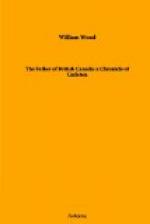Carleton was surprised: and well he might be. He had not supposed that Montgomery’s men were in any such commanding position. But, like Cramahe at Quebec, he refused to answer; whereupon Easton’s batteries opened both from the south shore and from Isle St Ignace. Carleton’s heaviest gun was a 9-pounder; while Easton had four 12-pounders, one of them mounted on a rowing battery that soon forced the British to retreat. The skipper of the schooner containing the powder magazine wanted to surrender on the spot, especially when he heard that the Americans were getting some hot shot ready for him. But Carleton retreated upstream, twelve miles above Sorel, to Lavaltrie, just above Berthier on the north shore, where, on attempting to land, he was driven back by some Americans and habitants. Next morning, the 16th, a fateful day for Canada, the same Major Brown who had failed Ethan Allen at Montreal came up with a flag of truce to propose that Carleton should send an officer to see for himself how well all chance of escape had now been cut off. The offer was accepted; and Brown explained the situation from the rebel point of view. ’This is my small battery; and, even if you should chance to escape, I have a grand battery at the mouth of the Sorel [Richelieu] which will infallibly sink all of your vessels. Wait a little till you see the 32-pounders that are now within half-a-mile.’ There was a good deal of Yankee bluff in this warning, especially as the 32-pounders could not be mounted in time. But the British officer seemed perfectly satisfied that the way was completely blocked; and so the Americans felt sure that Carleton would surrender the following day.
Carleton, however, was not the man to give in till the very last; and one desperate chance still remained. His flotilla was doomed. But he might still get through alone without it. One of the French-Canadian skippers, better known as ‘Le Tourte’ or ‘Wild Pigeon’ than by his own name of Bouchette because of his wonderfully quick trips, was persuaded to make the dash for freedom. So Carleton, having ordered Prescott, his second-in-command, not to surrender the flotilla before the last possible moment, arranged for his own escape in a whaleboat. It was with infinite precaution that he made his preparations, as the enemy, though confident of taking him, were still on the alert to prevent such a prize from slipping through their fingers. He dressed like a habitant from head to foot, putting on a tasselled bonnet rouge and an etoffe du pays (grey homespun) suit of clothes, with a red sash and bottes sauvages like Indian moccasins. Then the whaleboat was quietly brought alongside. The crew got in and plied their muffled oars noiselessly down to the narrow passage between Isle St Ignace and the Isle du Pas, where they shipped the oars and leaned over the side to paddle past the nearest battery with the palms of their hands. It was a moment of breathless excitement; for the hope of Canada was in their keeping and no turning back was possible. But the American sentries saw no furtive French Canadians gliding through that dark November night and heard no suspicious noises above the regular ripple of the eddying island current. One tense half-hour and all was over, The oars were run out again; the men gave way with a will; and Three Rivers was safely reached in the morning.




